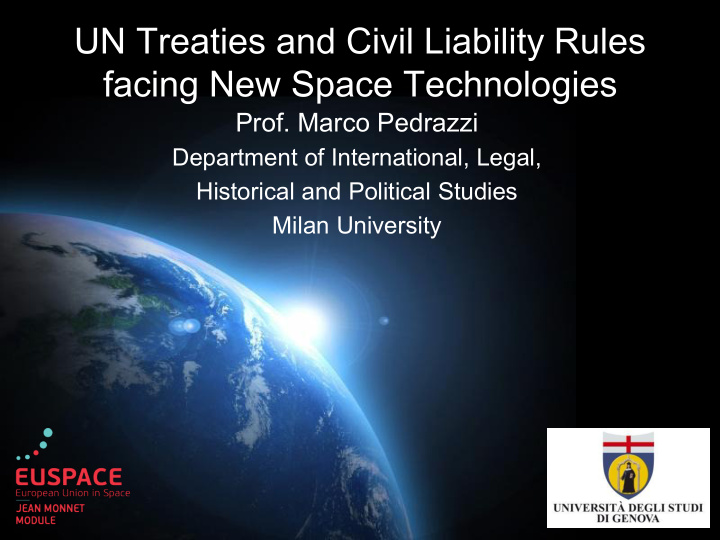



UN Treaties and Civil Liability Rules facing New Space Technologies Prof. Marco Pedrazzi Department of International, Legal, Historical and Political Studies Milan University 1
Liability in Air Law Air Law Damage civil (contract / tort) liability • Damage to passengers Warsaw Convention 1929 Montreal Convention 1999 liability of the carrier (limits) [national law] • Damage to third parties Rome Convention 1952 liability of the operator (limits) / national law 2
Aircraft • Chicago Convention on International Civil Aviation, 7 December 1944, Annex 7 • Aircraft is any machine that can derive support from the reactions of the air other than the reactions of the air against the earth’s surface
Liability in Space Law in Air Law / Space Space Law Law Damage inter-State liability • Responsibility = duty to control the activities of private entities bearing of the legal consequences when private entities violate international space law • Liability = obligation to pay compensation when a space object causes damage
Responsibility in Space Law in Air Law / Space Law in • Art. VI, Outer Space Treaty (OST, 1967) Air Law / Space Law • States Parties to the Treaty shall bear international responsibility for national activities in outer space , including the Moon and other celestial bodies, whether carried on by governmental agencies or by non- governmental entities , and for assuring that national activities are carried out in conformity with the provisions of the present Treaty
Responsibility in Space Law Air Law / Space Law • Art. VI, OST Page Title • The activities of non-governmental entities in outer space shall require authorization and continuing supervision by the appropriate State Party to the Treaty • relevance of national space legislations
Liability in Space Law Space Law Page • Article VII, OST Title • Each State Party to the Treaty that launches or procures the launching of an object into outer space and each State Party from whose territory or facility an object is launched is internationally liable for damage to another State Party or to its natural or juridical persons by such object on the Earth , in air space or in outer space
The Liability Convention • Convention on International Liability for Damage Caused by Space Objects (Liability Convention or LC), 29 March 1972
Absolute liability • Art. II, LC • A launching State shall be absolutely liable to pay compensation for damage caused by its space object on the surface of the Earth or to aircraft in flight • No exoneration is admitted, unless the launching State proves fault of the victim (Article VI.1) • No exoneration whatever for activities in violation of international law (Article VI.2)
Fault liability • Art. III, LC • In the event of damage being caused elsewhere than on the surface of the earth to a space object of one launching State or to persons on board by a space object of another launching State, the latter shall be liable only if the damage is due to its fault or to the fault of persons for whom it is responsible
Launching State • Article I (c), LC • The term “ launching State ” means: – A State which launches (1) or procures the launching (2) of a space object – A State from whose territory (3) or facility (4) a space object is launched
Space object • Article I (d), LC • The term “ space object ” includes component parts of a space object as well as its launch vehicle and parts thereof • Article I (b): the term “ launching ” includes attempted launching
Civil liability? • Art. XI.2, LC • Nothing in this Convention shall prevent a State, or natural or juridical persons it might represent, from pursuing a claim in the courts … of a launching State. A State shall not, however, be entitled to present a claim under this Convention in respect of the same damage for which a claim is being pursued in the courts … of a launching State or under another international agreement binding on the States concerned • role of national space legislations
New technologies • small satellites space law liability regime(s) --- problems • sub-orbital flights?
Sub-orbital flights • ICAO: «A sub-orbital flight is a flight up to a very high altitude which does not involve sending the vehicle into orbit» • Different kinds of vehicles being experimented • 2 main models: VTVL (e.g. New Shepard) and HTHL (e.g. Virgin Galactic’s Spaceships)
Sub-orbital flights • Applicability of air law? • In some models (e.g. Spaceship) the first stage may be considered an aircraft , but not the second one • Applicability of space law? • It depends on the definition of space object , which is in fact not fully defined
Sub-orbital flights • 1975 Registration Convention • Art. II • When a space object is launched into Earth orbit or beyond , the launching State shall register the object • What does «beyond» mean? • Does the limit apply to the Liability Convention?
Sub-orbital flights • Anyway, a space object is an object «launched into outer space» • The boundary between airspace and outer space is however not defined, although «Earth orbit» and «beyond» are clearly outer space
Sub-orbital flights • National legislations do not solve the problem • Some of them (e.g. US) tend to regulate sub- orbital flights as space activities, others (European laws) tend to equate them to aeronautical activities (or do not provide for any specific regulation) • Some national space acts (e.g. Australia, Kazakhstan, Denmark) point to a boundary at 100 km above sea level, but most of them do not define any boundary
Sub-orbital flights • Which way forward?
Recommend
More recommend